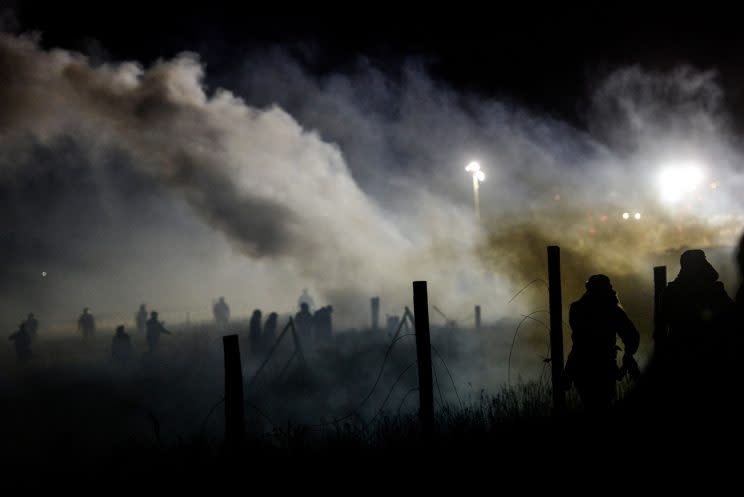What’s behind the Dakota pipeline protests?
The conflict over the construction of an oil pipeline in North Dakota flared up again Sunday night. At least 17 protesters were taken to the hospital after authorities used tear gas, rubber bullets and water hoses to disperse a crowd of 400 people who had gathered there in subfreezing temperatures. Some were treated for hypothermia, organizers said, drawing the ire of critics, including Vermont Sen. Bernie Sanders, who urged President Obama to protect the safety of those peacefully protesting the Dakota Access pipeline. Police defended their decision to use force, citing an “ongoing riot.”
The clash between protesters and police came a day after actress Kristen Wiig asked viewers of NBC’s “Saturday Night Live” to “please stand with Standing Rock,” the Sioux Indian tribe whose reservation lies near the pipeline route.
What is the Dakota Access pipeline?
The 1,172-mile pipeline is being constructed across four states — North Dakota, South Dakota, Iowa and Illinois — and is scheduled to carry 470,000 gallons of crude oil a day from fields in North Dakota to an existing refinery in Illinois. Construction on the $3.8 billion project, which gained full state approval in March, is nearly complete.
Why are people protesting it?
A section of the pipeline that is slated to cross under the Missouri River is less than one mile from the Standing Rock Reservation. The tribe and its allies argue that it could leak and pollute Lake Oahe, Standing Rock’s sole water source, and disrupt the surrounding religious, burial and cultural sites. But Energy Transfer Partners, the developer of the project, says the pipeline transports oil more safely than trucks and will not harm the tribe’s sacred land.
When did the protests start?
In April, an elder member of the Standing Rock Sioux tribe established the Sacred Stone Camp in Cannon Ball, N.D., to protest the pipeline shortly after construction began. The protests drew indigenous people from all over the country, at one point resulting in what was described as the largest gathering of Native Americans in more than 100 years. On social media, the hashtag #NoDAPL has been used to protest the pipeline.

Who’s been leading them?
Standing Rock and several supporting Native American tribes, as well as activists including filmmaker and actor Mark Ruffalo and actress Shailene Woodley, who was among 27 people arrested in October during what she described as a peaceful protest. Woodley’s arrest was streamed live to tens of thousands of viewers on her Facebook page. Filmmaker Deia Schlosberg and journalist Amy Goodman were also arrested while covering the protests.
Have there been other clashes?
Yes. In late October, violence broke out when a group of protesters tried to create a second camp. According to the Washington Post, “hundreds of law enforcement officers in riot gear used pepper spray, rubber bullets and high-pitched noise cannons to disperse the activists who refused to leave, arresting 141 people in the process.” Some protesters “set fires and threw rocks and Molotov cocktails at authorities, and at least one protester fired a gun,” police said. Similar clashes have been reported in recent weeks, including the one that occurred Sunday, but most of the demonstrations have been peaceful.
In August, a group of Standing Rock youth traveled to Washington, D.C., to deliver a Change.org petition opposing the pipeline to President Obama and to the U.S. Army Corps of Engineers. The petition now has more than 400,000 signatures.

Where does Obama stand?
In July, the Standing Rock tribe filed an injunction against the Army Corps of Engineers to stop building on the pipeline. But in September, a federal judge denied the request, and the Obama administration intervened.
The Army Corps “will move expeditiously to make this determination, as everyone involved — including the pipeline company and its workers — deserves a clear and timely resolution,” the Department of Justice, U.S. Army Corps of Engineers and Department of the Interior said in a joint statement that month. “In the interim, we request that the pipeline company voluntarily pause all construction activity within 20 miles east or west of Lake Oahe.”
Earlier this month, President Obama said his administration was considering ways to “reroute” the pipeline.
“My view is that there is a way for us to accommodate sacred lands of Native Americans,” Obama said in an interview with NowThis. “We’re going to let it play out for several more weeks and determine whether or not this can be resolved in a way that I think is properly attentive to the traditions of First Americans.”
What’s next?
On Nov. 15, the Army Corps of Engineers formally announced it had again delayed construction on the pipeline to hold further “discussion and analysis” with Standing Rock Sioux tribe. But the companies behind the pipeline slammed the decision as “lacking legal or factual justification,” and have asked a federal court to allow them to complete the project.
Until then, the protests will likely continue.



